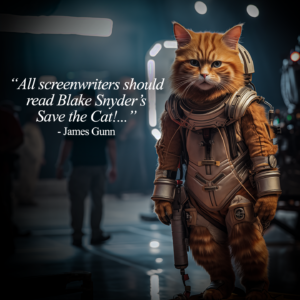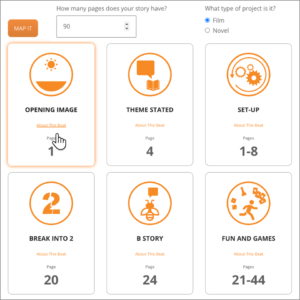
José Silerio served as Blake Snyder’s Development Director. He has been integral to the success of Blake’s workshops and classes as he worked alongside Blake schooling writers in the Cat! method. As a teacher and consultant, José continues to help numerous writers learn Blake’s paradigm and apply it to their projects. You can see José as he leads one of the “Power Half Hours” at the Your Career in a Day event in Burbank on June 1. In today’s blog, José offers some guidance in an often challenging section of your script:
“Why is the Bad Guys Close In beat soooo hard?”
Ever felt that way? I hear it every time in workshops. Blake even says it in the book. The BGCI is the toughest part of the screenplay. It’s the part of the script he always had trouble with.
Remember, the BGCI beat does not only refer to the external forces that are hunting your hero down. This isn’t just the villains tightening their grip. The BGCI also refers to the internal forces that are making your hero’s journey much harder.
This is the section wherein internal dissent takes place. This is where your hero’s resolve in obtaining his goal is truly tested. It doesn’t just get harder because your hero’s enemies have found a way to regroup (if you gave your hero a false victory at Midpoint… but let’s save that for another blog) and are back on the chase. It gets harder because your hero doubts himself and whether the goal he’s been chasing all these 55 or so pages is really the right goal after all.
In Silver Linings Playbook, Pat (Bradley Cooper) was very clear with his goal from the get-go: win Nikki (his ex) back. He has a great false victory at Midpoint when Tiffany (Jennifer Lawrence) agrees to give Nikki his letter that will win her back – but only if he dances with Tiffany. Now that the external stakes are raised — learning to dance and all the pressures that go with it (especially if you’re bipolar) — Pat discovers something else. His life is actually going ok. Not only is he happy (a call back to the theme stated; check out the previously posted beat sheet of SLP), but he’s actually happy with Tiffany – not Nikki. Now the internal stakes are being raised.
This is where I like to say: The BGCI is where the hero learns the problem was never them. The problem was me. And once that grain of doubt gets planted in your hero, the internal BGCI happens. Now your story is raised to another level. Now your BGCI doesn’t merely repeat your Fun & Game moments. Now your BGCI beat becomes stronger.
What will your hero do to resist change? What will your hero do to fight the biggest battle he must overcome – himself?
Isn’t it always hardest to admit when we’re wrong (especially when arguing with your spouse or – heaven forbid – your mother-in-law!)? Well, it’s the same for your hero. He now knows he must change. He was wrong. “His way or the highway” doesn’t work anymore. He can no longer get away with the lie he’s been telling, or passing the blame all the time, or running away from his biggest fear (whatever that may be in your story).
The external BGCI forces your hero to face his internal BGCI. It’s a one-two punch. And that’s how your hero goes down for the count in the All Is Lost (… or so we think – but that’s another discussion for yet another day).
And that’s why BGCI is soooo hard … for our hero and us, the writer. Not to get all Dr. Phil here, but we have to tap into our emotions, our fears, our pains as writers and put it in paper through our heroes. It’s easy to add plot (just drop an anvil, kitchen sink, or piano at your hero), but it’s a heck of a challenge to build character.
And that’s what we, as writers, have to do. If you’re unsure how to push your story forward past Midpoint and struggling through your BGCI, maybe you need to jiggle your structure a bit. Do you have the right goal for your hero? Did you set up enough character flaws in the 1st Act? Do you have the right theme (I know, I shouldn’t have gone there – and, yes, that is a discussion for yet another day)?
Hey, nobody said it would be easy – but doesn’t everyone also say don’t quit just because it gets hard?
It may be tough writing the BGCI, but the harder we make it for our hero, the greater the reward will be for our hero and our audience. And that’s the only goal that truly matters in the end.
Jose Silerio
2 Comments
Leave a Reply Cancel reply
You must be logged in to post a comment.









Great blog, Jose. I especially liked the insight about the necessity for the internal BCGI. I totally agree with that. But I think another reason people may have trouble with this beat is that it’s not just one beat. It’s really two or more. The BS2 shorthands this beat the same way it shorthands Fun & Games. When beating out a story I think it’s helpful for people to think of it this way: “Fun & Games – Repeat Twice.” “BGCI – Repeat Twice.” (and maybe a third time if you include the internal BGCI beat, which again, I think is a good idea). There’s a lot of real estate (and by that I mean page count) from F&G to the Midpoint, and from BCGI to All is Lost. Two much for one simple beat to take you the distance. That’s my experience, anyway. Repeat Twice. At least. If folks think of it only as one beat they might have trouble generating enough plot. Hopefully this will help people with this difficult beat — but one of the most fun, too, since it focuses on confrontation and getting the hero into serious trouble!
Positively brilliant observation, explanation. Grappling with internal dissent. Bad Guys are actually within. May have been wrong all along. But what kicks MC into gear to keep going, with newfound realization? Just thinking this all through…